Tarke’s Takes: SDSU’s escape from the Elite Eight
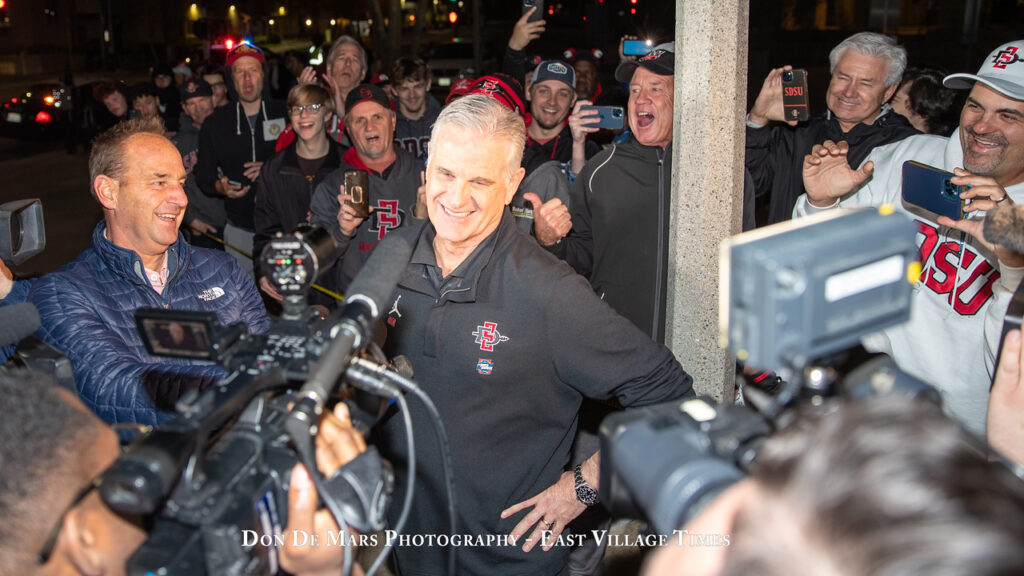
Brian Dutcher laughs with the media after the team returned home following the Elite Eight. (Don De Mars/EVT)

“The moment wasn’t too big for me,” Darrion Trammell said after hitting the game-winning free throws against Creighton. “Everything that I’ve been through, the opportunity was set there for me; it was God’s timing. I just had to have the confidence that, yeah, I missed the first one, but I definitely wasn’t going to miss the second one.”
The Aztecs have capitalized on the moment throughout the tournament. They have made winning plays over the course of 40 minutes and find themselves two wins away from becoming NCAA Tournament champions.
Guard play wins in March
Winning the NCAA tournament takes six consecutive wins. The field is comprised of the top 68 teams in the country, who are all skilled in their individual ways. Each matchup possesses mismatches, physical advantages, and talented players on each roster.
Games that come down to the wire are usually decided by who has the ball in their hands during the crucial final stretch of the game. The responsibility usually lands on the point guard.
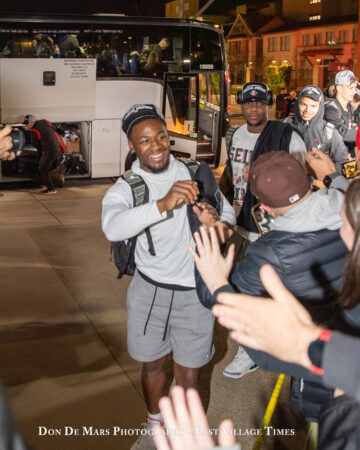
Being the floor general, they are responsible for keeping the team under control and for creating a play when the team needs it most. With the Aztecs advancing to the Final Four, the credit can be attributed to the fantastic play of Darrion Trammell and Lamont Butler.
Looking back to previous great Aztec teams, they all had a common theme, an elite point guard. In 2011, it was DJ Gay, a player who created for teammates and rarely committed errors. In 2014, Xavier Thames was known for his ability to hit late-game free throws and shots. The 30-2, 2020 team was led by Malachi Flynn, a tremendous scorer. Both Butler and Trammell have embodied these characteristics through the first four games of the NCAA tournament.
Trammell was named MVP of the South region. He averaged 12.75 points a game, led the charge with 21 points against Alabama, and hit the biggest free throw of his life against Creighton.
“What he did the past two games, we’ve seen in practice and games over a hundred times,” Aguek Arop said after the win against Creighton.
But it was not just his scoring outbreak that gave him the tournament honors. The 5’10, 175-pound guard stifled opposing ball handlers. Bluejay, Ryan Nembhard injured his wrist during the game. He checked back in, and Trammell gave him zero air space, keeping him uncomfortable. After returning, he only attempted one shot.
“Darrion is a big-time player for our team,” Butler said. “You’ve seen the scoring outbreaks the last couple of games, but it’s really the defensive side, the pressure that he puts on the point guard, we love him, and we need him.”
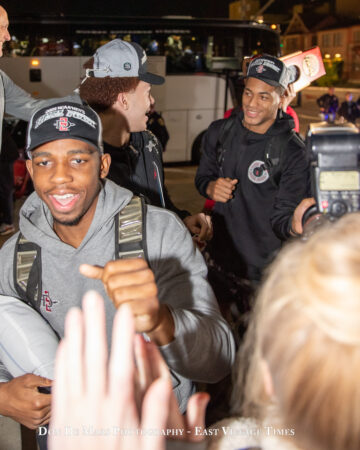
The duo of Butler and Trammell on the defensive end makes opposing guards miserable with their consistent ball pressure. It also negates the other team’s ability to get their guards in a rhythm to potentially make a play late in the game.
Against Charleston, starting guard Ryan Larson scored 11 points on 4-for-12 shooting, 1-for-6 from beyond the arc. Furman’s JP Pegues, who hit the game-winner against Virginia, shot 3-for-15 on his field goals. Alabama’s Jahvon Quinerly shot 4-for-13. Creighton’s starting guards combined for 7-for-19 shooting.
Trammell’s timely baskets and the game-winning free throw against the Bluejays will never be forgotten. But Butler’s scoring performance advanced the Aztecs to the Final Four.
He finished the game with 18 points on 8-for-11 shooting. He set the tone early, finding his rhythm in the first half.
Asked what he was seeing on the floor, he said, “Just getting to my spots in the midrange, knocking those down, shots I hit all year, shots I work on. I had some open looks for three that I took, and I was fortunate that they went in.”
His most important work came early in the second half to keep the Aztecs afloat.
With 13 minutes left, Creighton had a seven-point lead and was gaining momentum. The Bluejays scored on three consecutive possessions, and the Aztecs were struggling to answer. After missing back-to-back layups, Keshad Johnson snatched an offensive rebound and found Butler open beyond the arc for a very timely three.
Creighton followed that by scoring again, their fourth consecutive possession. The Aztecs, on their heels, needed another answer. After Butler missed a layup, he crept behind Nembhard like a snake and poked the ball free for an easy layup for himself. These two plays may seem insignificant in the box score, but they played a major role in denying Creighton a chance to extend its lead. The Bluejays went the next four minutes without a point, and the Aztecs were able to eventually gain control.
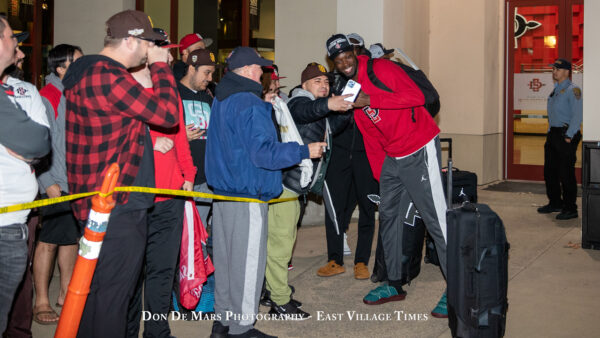
The closing lineup
Aztec fans can vividly recall the dramatic fashion in which SDSU’s season ended last year against Creighton. The team gave up a nine-point lead but found themselves in a tie game with two seconds left. Their best player, Matt Bradley, stepped to the free-throw line for a one-and-one.
He missed. The game went to overtime, and the rest is history. Bradley was seen as the choke artist and was scrutinized all year.
He has since exorcized the demons of failing in late-game scenarios. The perfect fairy tale ending in a rematch against the Bluejays would have given Bradley a chance to win the game.
Head Coach Brian Dutcher did not care for fantasy endings. He coaches to win basketball games.
After scoring two points and going 1-for-8 from the field, Bradley was subbed out with 7:40 left and never returned.
“This is truly riding the guys who are playing the best,” Dutcher said afterward. “At the end of the game, the guys who are playing the best for the majority of the 40 minutes are in at the end, and that’s what we had.”
The key lineup to end the game was Trammell, Butler, Adam Seiko, Arop/Keshad Johnson, and Nathan Mensah.
Subtracting Bradley may have been done for defensive purposes. He had trouble guarding Arthur Kaluma, But it also may have been done for Dutcher’s indescribable feel for who on his team is playing their best basketball.
Against Alabama, Bradley started the game 0-for-7 and was used late in the game to secure the victory. In the waning moments of the Creighton game, Bradley remained seated. Even on the final possession of the game, Bradley was not even used as a decoy.
Throughout the year, Dutcher has taken advantage of his depth and used all of his weapons at every stage in a game. He does not need to tend to his players’ feelings because they understand the philosophy. As impressive as this approach was during the regular season, that Dutcher has continued it with the stakes as high as they are is masterful.
“Depth isn’t a strength unless they embrace it, and this team embraces it,” Dutcher said. Bradley may wish that he was given an opportunity to aid his team more, but if he plays up to his standards in the upcoming games, he will have an opportunity to win an NCAA championship.
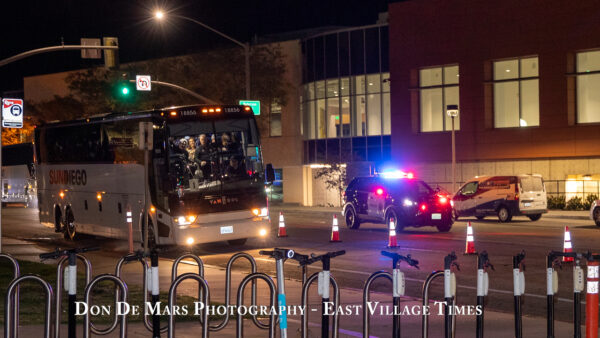
The final foul call
SDSU made history. A team from a mid-major conference advanced to its first Final Four ever. Tears streamed from players’ faces as they realized what they accomplished. They played 40 minutes of basketball and came out on top.
Postgame, the talk was not about what transpired the first 39:58.8 seconds of the game. It was about SDSU’s final possession, specifically, the final 1.2 seconds. The conversation revolved around Nembhard’s left hand that was attached to Trammell’s hip as he drove for the game-winning field goal. There was contact, maybe minimal; it is a clear foul at any other stage in the game. But, on the final play of the game, there is a tendency for refs to swallow their whistle. The foul was called, SDSU advanced.
“I think I got fouled, but that was up for the refs to decide,” Trammell said.
There has been a media roar over the foul. Most agree it was a foul but still should not have been called at that stage in the game and in Creighton’s season. The officials are tasked with making the correct call every time down the court. They follow the rulebook and understand the standard. There is no rule for letting the kids play when there are under two minutes in a game. The official believed that enough contact was made to alter Trammell’s shot.
“I was in Michigan in 1989, where people questioned if Rumeal Robinson was fouled, and he made two free throws, and we won a national title,” Dutcher said. “This is not the first time that fouls have been called at the end of NCAA tournament games.”
The Bluejays also benefited from multiple calls throughout the game. They committed one foul through the first 17 minutes of the game and one through the first 13 minutes of the second half. The referees’ calls will always be discussed, but at the end of the game, it is magnified.
The storyline after the game should have been on SDSU’s stellar second-half defense that got them to an advantageous point at the end of the game.
After shooting 53.6% from the field in the first half, Creighton went 8-29 (27.6%) in the next 20 minutes. They scored 23 second-half points, their lowest total of the season. They shot 2-for-17 from beyond the arc, their worst shooting percentage of the year.
SDSU made winning plays at the right time and put themselves in a position to win the game. They needed a whistle to finish the Bluejays, but the win was decided over the course of the game.
Class of 2022 at San Diego State University. Communication major and pursuing a sports journalism profession. Season ticket holder of the SDSU MBB team since 2011. Fondest memory of Viejas Arena is Aztec legend, Dwayne Polee sparking a 19-1 run over New Mexico to win the MW Conference in 2014.